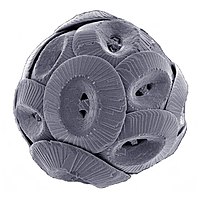
Photo from wikipedia
Widespread wastewater pollution is a major barrier to the sustainable management of freshwater and coastal marine ecosystems worldwide. Integrated multi-disciplinary studies are necessary to improve waterway management and protect ecosystem… Click to show full abstract
Widespread wastewater pollution is a major barrier to the sustainable management of freshwater and coastal marine ecosystems worldwide. Integrated multi-disciplinary studies are necessary to improve waterway management and protect ecosystem integrity. This study used the Generalised Likelihood Uncertainty Estimation (GLUE) methodology to link microbial community ecotoxicology laboratory data to a mechanistic aquatic ecosystem response model. The generic model provided good predictive skill for major water quality constituents, including heterotrophic bacteria dynamics (r2 = 0.91). The model was validated against observed data across a gradient of effluent concentrations from community whole effluent toxicity (WET) laboratory tests. GLUE analysis revealed that a combined likelihood measure increased confidence in the predictive capability of the model. This study highlights the importance of calibrating aquatic ecosystem response models with net growth rates (i.e., sum of the growth minus loss rate parameter terms) of biological functional groups. The final calibrated net growth rate value of heterotrophic bacteria determined using the GLUE analysis was selected to be 0.58, which was significantly greater than the average literature value of -0.15. This finding demonstrated that use of literature parameter values without a good understanding of the represented processes could create misleading outputs and result in unsatisfactory conclusions. Further, fixed bulk mineralisation rate literature values are typically higher than realistically required in aquatic ecosystem response models. This indicates that explicitly including bacterial mineralisation is crucial to represent microbial ecosystem functioning more accurately. Our study suggests that improved data collection and modelling efforts in real-world management applications are needed to better address nutrients released into the natural environment. Future studies should aim to better understand the sensitivity of aquatic ecosystem response models to bacterial mineralisation rates.
Journal Title: Water research
Year Published: 2021
Link to full text (if available)
Share on Social Media: Sign Up to like & get
recommendations!